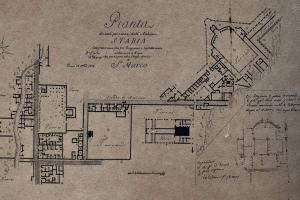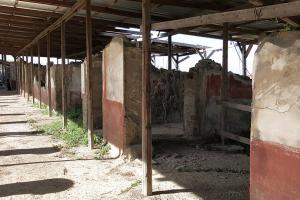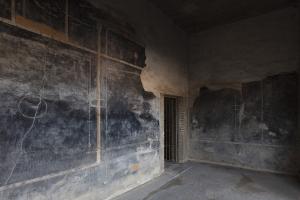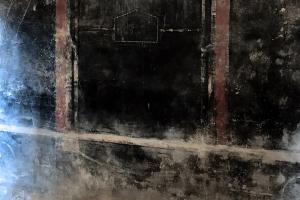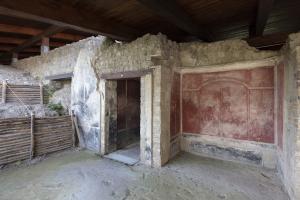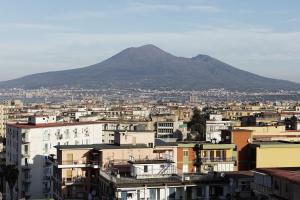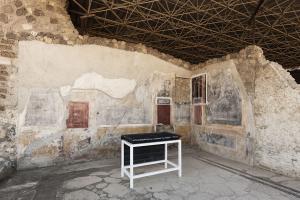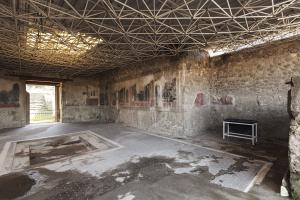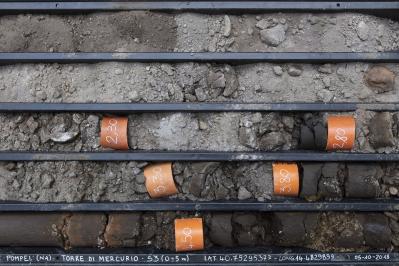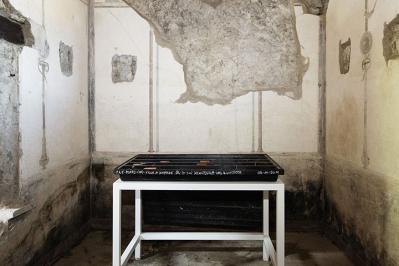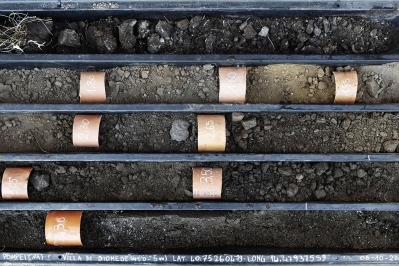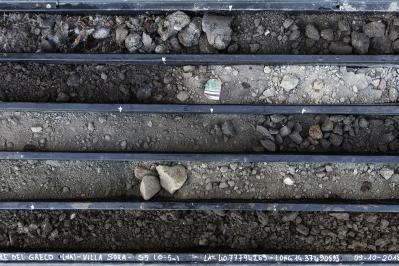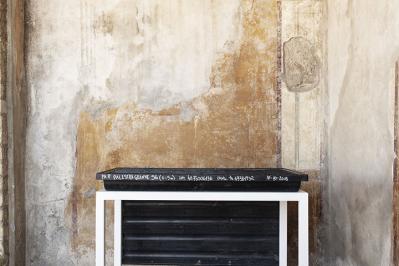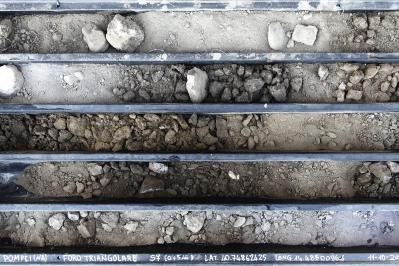Until the eruption of Vesuvius in AD 79, luxurious summer villas were built by Imperial aristocrats on the Varano hill, which dominates present-day Castellammare di Stabia. The Villa Arianna, the oldest in the whole area, stood on the western edge of the promontory. When viewed from the sea, the base of the villa offered a play of perspective that was carefully designed to adapt to the shape of the cliff, with a long series of terraces with pergolas, gardens, and nymphaea sloping down on six levels, with a path leading down to a private berth below.
The reception rooms looked out over the Gulf of Naples, and the spa, the storage rooms and the stables of the Villa Arianna still convey an impression of the opulence and splendour that greeted the visitor back in the day. A long, steep, barrel-vaulted underground ramp leads down from the level of the residence to the base of the hill – the tunnel was dug beneath the terraces that originally looked out over the sea. The outdoor path has been lost, but a nymphaeum and a monumental fountain partially destroyed by a landslide still remain. Bourbon archaeologists carried off marbles, frescoes and decorative mosaics and, in addition to this, over the years looters have to some extent tampered with what was found, still intact, beneath the dust of the eruption.
A villa maritima devoted to summer leisure, or otium, the residence adopted a design similar to that of others in the area (including the so-called Villa San Marco), reflecting the late Hellenistic tastes of the 2nd century BC. The first finds were unearthed in 1757 and included mosaics and frescoes, now in the National Archaeological Museum in Naples, that were detached from the original walls and taken to Bourbon residences and institutions such as the Bourbon Museum at the Royal Palace in Portici. These works helped shape the neoclassical aesthetic in the eighteenth and nineteenth centuries. Fragments of the fresco of Flora and of The Cupid Seller have been reproduced – almost mass-produced – by painters, decorators and porcelain makers across all Europe ever since they were first discovered. The overexposure of these images, made to satisfy middle-class tastes, led the poet Charles Baudelaire to criticise the lack of imagination in the choice of subjects. The fresco that was found in 1950 and can still be seen on the rear wall of the central triclinium, and that gives the Villa Arianna its present name, shows the mythical Cretan princess Ariadne linked to the myth of the Minotaur.
On the slopes of the Varano hill, right opposite the Villa Arianna, is the Grotta di San Biagio, the quarry from which tuff was extracted for the construction of the residences of Imperial aristocrats throughout the area. According to some sources, the cave was dedicated to the cult of the god Pluto in Roman times.
From its dominant position, the Villa (which now forms part of the Archaeological Park of Pompeii) offers views over the entire Gulf of Naples: from the Rock of Rovigliano – the Petra Herculis of myth – all the way to Vesuvius, which looms up in the background. The sweeping view from the Villa Arianna of the surrounding landscape reveals not only its geological history but also its anthropological history, which has taken shape over the centuries. It is like a vertical core sample that – if one includes the reliefs of the volcano and the surface of the sea in the distance – is occupied in the centre by a densely populated and chaotically urbanised contemporary landscape, created by historical urban transformations carried out over the centuries, not least by the building speculation of the municipalities around Vesuvius. The view from the belvedere of the Villa Arianna thus offers a map of human presence on the Vesuvian plain with all its magnificence and its destruction: the early-twentieth-century facades and the tower blocks built in the 1960s and 1970s on the seafront and, further away, the eighteenth-century villas of the Golden Mile; the unauthorised constructions from the turn of the twentieth century that fill every gap that was once left to nature. Not even today’s “red zone” – the area that would be destroyed in a hypothetical future eruption of Vesuvius – is free from villas, warehouses, and blocks of flats. On the horizon, beyond the formidable mass of Vesuvius, lie Naples and the hill of Posillipo.
The core samples made as part of the project went on display in the exhibition DIGGING UP: ATLAS OF THE BLANK HISTORIES / Indagare il sottosuolo. Atlante delle storie omesse (25 Oct – 18 Nov 2018). The core samples were shown in their standard storage boxes on tables in the various rooms of the villa, and the display gave visible, tangible form to the profound stratification of the surrounding territory. Like horizontal timelines, they made it possible to read the stories that have been impressed upon the ground over the centuries: the discovery in 1936 of the enigmatic magic square (with the inscription TENET) on a column of the Great Palaestra of ancient Pompeii; the Triangular Forum, which legend has it is where the mythical tomb, or heroon, of Hercules is located, and the Temple of Isis (second century BC), which was unearthed in 1764, arousing great interest in Egyptology and occultism, which spread far and wide across Europe at the time, influencing contemporary tastes; and the suburban sanctuary in the Fondo Iozzino, where the ancient pagan cult, as testified to by many votive offerings, dates back to the end of the seventh century BC. These miniature objects – jars, chalices and bowls for libations – connect with the Catholic cult of the Madonna del Rosario and with the devotional ex-votos preserved in the nineteenth-century sanctuary, showing the break between – but also the continuity of – the different cults.
The uniqueness of the area is set out in stories, documents and legends handed down by the local inhabitants, who helped select the sites where the extractions were made.
The core samples inside the Archaeological Park of Pompeii were taken from the Large Palaestra, the Tower of Mercury, the Villa of Diomedes, and the Triangular Forum. In external areas administered by the Archaeological Park of Pompeii, core extractions were carried out at the Suburban Sanctuary in the Fondo Iozzino (Pompeii), Villa Sora (Torre del Greco), and Villa San Marco (Castellammare di Stabia). In the area administered by the City of Pompeii, they were made in Messigno and close to the chapel of Santa Giuliana. Further operations were carried out at the archaeological park of Herculaneum and at the National Institute of Geophysics and Volcanology in the National Park of Vesuvius.







